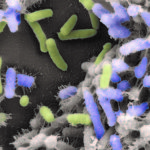Lien vers Pubmed [PMID] – 18237304
Environ Microbiol. 2008 Mar;10(3):685-701
The ability to form biofilm is seen as an increasingly important colonization strategy among both pathogenic and environmental Klebsiella pneumoniae strains. The aim of the present study was to identify abiotic surface colonization factors of K. pneumoniae using different models at different phases of biofilm development. A 2200 K. pneumoniae mutant library previously obtained by signature-tagged mutagenesis was screened in static and dynamic culture models to detect clones impaired at early and/or mature stages of biofilm formation. A total of 28 mutants were affected during late phases of biofilm formation, whereas 16 mutants displayed early adhesion defect. These mutants corresponded to genes involved in potential cellular and DNA metabolism pathways and to membrane transport functions. Eight mutants were deficient in capsule or LPS production. Gene disruption and microscopic analyses showed that LPS is involved in initial adhesion on both glass and polyvinyl-chloride and the capsule required for the appropriate initial coverage of substratum and the construction of mature biofilm architecture. These results give new insight into the bacterial factors sequentially associated with the ability to colonize an abiotic surface and reveal the dual roles played by surface exopolysaccharides during K. pneumoniae biofilm formation.

